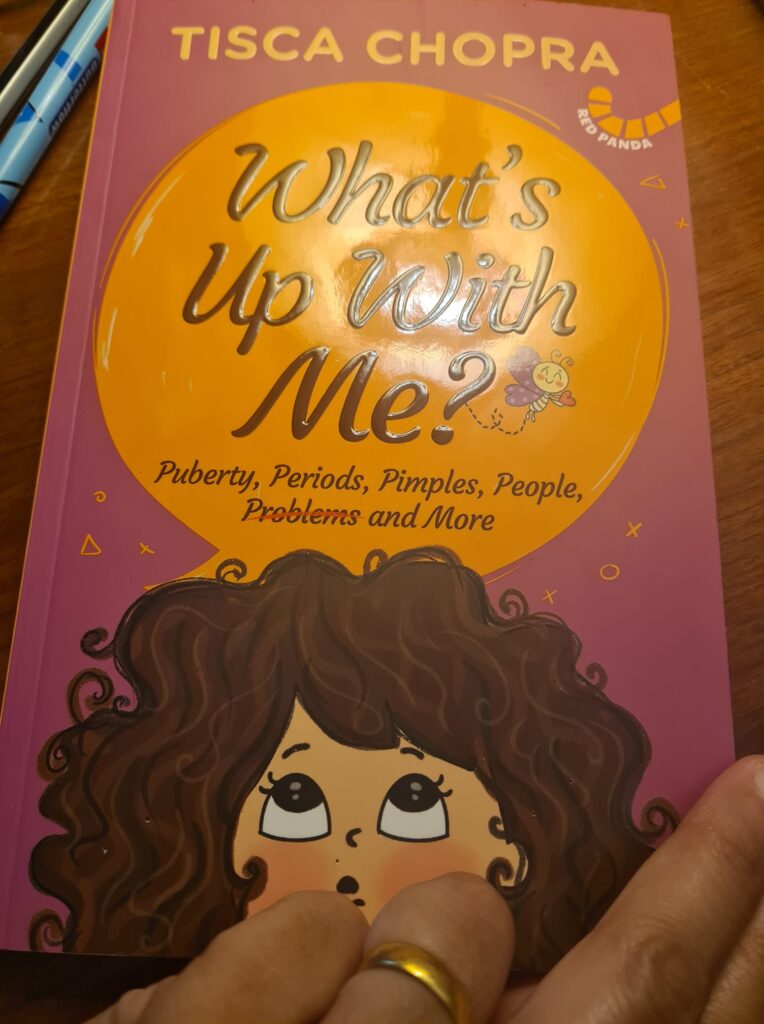Tisca Chopra’s “What’s Up With Me?: Puberty, Periods, Pimples, People, Problems and More”

At the best of times parenting can be exciting, thrilling and challenging. It is a heady cocktail that is a constant but wow! It can get explosive, unpredictable and at times, unmanageable, when the kids transition from childhood to adolescence. For no fault of theirs, their mood swings and irascible temperament coincides with their hormones kicking in. It requires immense amounts of patience and emotional reserves that no sane adult ever thought they were capable of possessing. Inevitably, there are moments when parents and child clash. It is all part of growing up.
For generations, Indians have gone through various stages of life, without any conversation revolving around the body and of course, sex, as taboo. It is simply not spoken about. So the dangers of experimentation and being ill-informed can lead to disastrous consequences. Or even hilarious instances as I discovered years ago while reading a newspaper report. The article was about precisely this — starting a helpline for youngsters to educate them about sex. One of the girls who called in was terrified that she may become pregnant as she had worn her brother’s trousers. This was an anecdote printed on the front page of the morning newspaper. The level of ignorance is abysmal. Fortunately, this scenario is changing slowly and steadily. Misinformation continues to exist but at least middle-class parents are actively seeking literature meant for youngsters that talks about bodily changes and sexuality. Schools too have taken the initiative to conduct sessions with students, in the presence of their counsellors and parents, discussing the body. Interestingly these classes are organised for children of upper primary onwards. Of course, the information is graded according to the level of the children. Even so, the point is that it is becoming a tad “easier” to introduce these topics of conversation rather than facing a complete shut down. The classic argument being that we do not talk about such things in our culture. And God forbid if these topics are to be introduced or discussed in the presence of girls or even about girl sexuality. These are conversations that lurk in the background, even now.
This is why books like What’s Up With Me?: Puberty, Periods, Pimples, People, Problems and More by Tisca Chopra are created. ( Published by Westland Books.) The author is a young mother. Realising that her daughter would soon be hitting puberty, she decided to create this book. It is written in a fun style. Flip any page and there are short entries that speak clearly to the young reader. There is no shame in talking about the body. In fact, Tisca Chopra actively encourages viewing one’s body and being familiar with it. It is an integral part of self-love and self-care. Of course, the book focuses upon personal hygiene, discusses the various kinds of changes the body will undergo such as sprouting hair and bleeding, describing the menstruation cycle etc. There are other aspects too that address the emotional and psychological changes that will occur such as friends drifting apart, emotional roller coaster, crushes and matters of the heart, its okay not to be okay, shout out the doubts, maintaining one’s mental equilibrium, developing good physical habits, exercise, being disciplined about using digital devices, and of course the big one —- (mis) understanding parents. Essentially communication is the key to navigate the choppy waters of adolescence and trusting the advice elders, especially parents, impart.
This is a slim book and for some inexplicable reason, very pink. But that should not deter children and adults alike to pick it up, read and have frank conversations. Sometimes it is easier to leave accessible literature lying around conveniently at home or in schools for kids to browse through. It is easier to read and glean information than have “embarassing” face-to-face conversations. Hence, it is imperative to have well-made material. In this case, the book has been created with inputs from gynaecologist, Dr Mala Arora, and practising counselling psychologist, Malavika Varma. No wonder the tenor of the book is spot on. So much so, when my eleven-year-old daughter browsed through the book, she asked in amazement, “Mum, have you been giving the author inputs on what to say?!” Err, no, I had not. But that is where the value add lies in this book. It validates what parents, especially mothers, have to say to their daughters. When they are at the cusp of childhood and adolescence, kids begin to shut their parents out. So a book like this is helpful as it speaks directly to the kiddos and enables constructive conversations within the family. Akanksha Agnihotri’s illustrations are smart and not girly at all. Yet, very expressive and never distracting from the text. The illustrations, in fact, complement the text beautifully.
It is a good book.
Having said that it may be apt at this juncture to recall an absolutely fantastic book on the female body that was created by Kali for Women in the 1990s. It was called “Shareer ki Jankari” ( “About the Body”). It was written by 75 village women and sold at a special price. It was a very simple paperback that discussed the body, especially menstrual taboos. It had these little paper flaps that you could lift and see the particular part of the body beneath and the changes it underwent. It was a phenomenal bestseller and if I am not mistaken, was translated into multiple regional languages as well. It was a path breaking book and if still available, continues to be relevant.
All in all, I would certainly recommend Tisca Chopra’s book for girls on the verge of becoming young women.
18 March 2021
